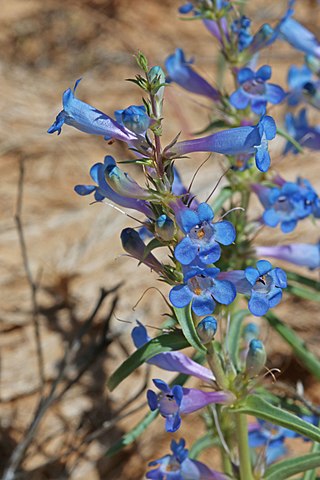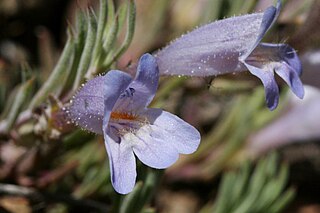
Penstemon anguineus is a species of penstemon known by the common name Siskiyou penstemon. It is native to the mountains of southern Oregon and northern California, where it grows in coniferous forests, often in open areas left by logging operations.

Penstemon californicus is a species of penstemon known by the common name California penstemon. It is native to Baja California and is also known from fewer than 20 occurrences in California, mainly in Orange and Riverside Counties. It grows in the forest and woodland habitat of the Peninsular Ranges and nearby slopes.

Penstemon thompsoniae, Thompson's beardtongue, is a low perennial plant endemic to the southwestern United States, where it grows in dry shrublands, woodlands and forests. It is considered a species of conservation concern in California.

Penstemon grandiflorus, known by the common names shell-leaved penstemon, shell-leaf beardtongue, or large-flowered penstemon, is a tall and showy plant in the Penstemon genus from the plains of North America. Due to its large flowers it has found a place in gardens, particularly ones aimed at low water usage like xeriscape gardens.

Penstemon angustifolius is a perennial semi-evergreen forb belonging to the plantain family. This species is 1 out of roughly 273 species of Penstemon. This species is also known as broadbeard beardtongue. This forb is native to central United States and can be noticed by its brightly and highly variable colored flowers.

Cheiranthera linearis, commonly known as finger-flower, is a flowering plant in the family Pittosporaceae. It is a small shrub with deep purple flowers, yellow stamens and dull green linear shaped leaves. It is found growing in New South Wales, Victoria and Queensland.

Olearia tenuifolia, commonly known as the thin-leaf daisy-bush, is a small shrub with narrow leaves and clusters of blue, deep mauve to purple flowers.

Penstemon whippleanus, commonly known as dusky penstemon, dusky beardtongue, Whipple's penstemon, or Whipple's beardtongue, is a summer blooming perennial flower in the large Penstemon genus. It is a widespread plant within the hemiboreal forests of the Rocky Mountains in North America. It is noted for the large deep purple-red flowers and a preference for high mountain elevations.

Penstemon virens, commonly known as blue mist penstemon, Front Range penstemon, or Green beardtongue, is a common Penstemon in the Front Range foothills in Colorado and Wyoming. The dainty flowers are an ornament to many rocky or sandy area within its range. It is confusingly similar to Penstemon humilis and Penstemon albertinus though the ranges of these plants do not overlap in the wild. The origin of calling it the "blue mist penstemon" is not precisely known, but is thought to relate to the large number of blue flowers the plant can produce reminding observers of a blue mist.

Penstemon secundiflorus, commonly known as sidebells penstemon, or orchid beardtoungue is a species of Penstemon that grows in dry forests, high plains, and scrub lands from Wyoming to Mexico. It is a herbaceous perennial plant that typically grows to a height of 20 to 50 cm and has narrow, lance-shaped leaves that are grayish-green in color. The flowers of the sidebells penstemon are tubular in shape and are arranged in a one-sided spike, with the blooms all facing the same direction, and for this reason was named "secundiflorus", which means "one-sided flowers". The flowers are most often delicate shades of orchid or lavender. It is sometimes used in xeriscaping, rock gardens, and wildflower meadows, and is well-suited to dry, sunny locations with well-draining soil.

Penstemon ambiguus, commonly known as the bush penstemon, pink plains penstemon, or gilia beardtongue is a species of Penstemon that grows in the shortgrass prairies and deserts of the western United States and northern Mexico. This bush-like penstemon grows in sandy, loose, and creosote soils and is particularly known for the spectacular flowering show it produces, sometime seasons turning whole hillsides bright pink–white.

Penstemon auriberbis, commonly known as the Colorado penstemon or Colorado beardtongue, is a species of Penstemon that grows in the shortgrass prairies of southern Colorado and in a few places in northern New Mexico. Although specimens were collected on the 1820 expedition by Stephen H. Long through the area, they were not scientifically described as a separate species until 1920.

Penstemon caespitosus, commonly known as mat penstemon, is a summer blooming perennial flower in the large Penstemon genus. It is a widespread plant from near timberline to the foothills in the Southern Rocky Mountains and Colorado Plateau in North America. It is noted for its ground hugging growth habit and as a plant used in xeriscape and rock gardening.

Penstemon cyathophorus, commonly known as cupped penstemon or Middle Park penstemon, is a species of flowering plant that grows in a small area in the mountains of northern Colorado and a smaller area of southern Wyoming. As a rare species with a limited range it is vulnerable to human development. It is not a large plant and is often found growing amid sagebrush plants in mountain basins and valleys.

Penstemon arenicola, commonly known as Red Desert penstemon, is a species of plant from the Western United States. It primarily grows in Wyoming, but it also grows in small areas of Colorado and Utah. It is a short plant known for growing in sand as referenced by its scientific name.

Sphaeralcea parvifolia, commonly called small-leaved globe-mallow or small-leaf globemallow, is a species of plant native to the western United States in the Great Basin and Colorado River drainage. It is medium sized herbaceous species that has showy orange flower spikes. It is used in wildflower and dry gardens.

Penstemon albifluvis, the White River penstemon, is a disputed species or variety of Penstemon that grows in a small area in eastern Utah and western Colorado. It grows mainly on broken shale and rock formations in desert habitats. White River penstemon is very rare.

Penstemon pruinosus is a species of flowering plant in the plantain family; its common name is the Chelan penstemon. It is native to Washington State and southern British Columbia on the east side of the Cascade Mountains.
Penstemon yampaensis, the Yampa penstemon, is a rare species of plant from the western United States. It grows in the Yampa River drainage of Colorado and Wyoming and westward into Utah. It is one of the more unusual penstemons, having almost no stem. It is threatened from habitat disturbance, particularly the invasion of the non-native cheatgrass.

Penstemon breviculus, the narrow-mouth penstemon or shortstem penstemon, is a species of perennial flowering plant from the dry forests and steppes of the Colorado Plateau in the western United States.




















